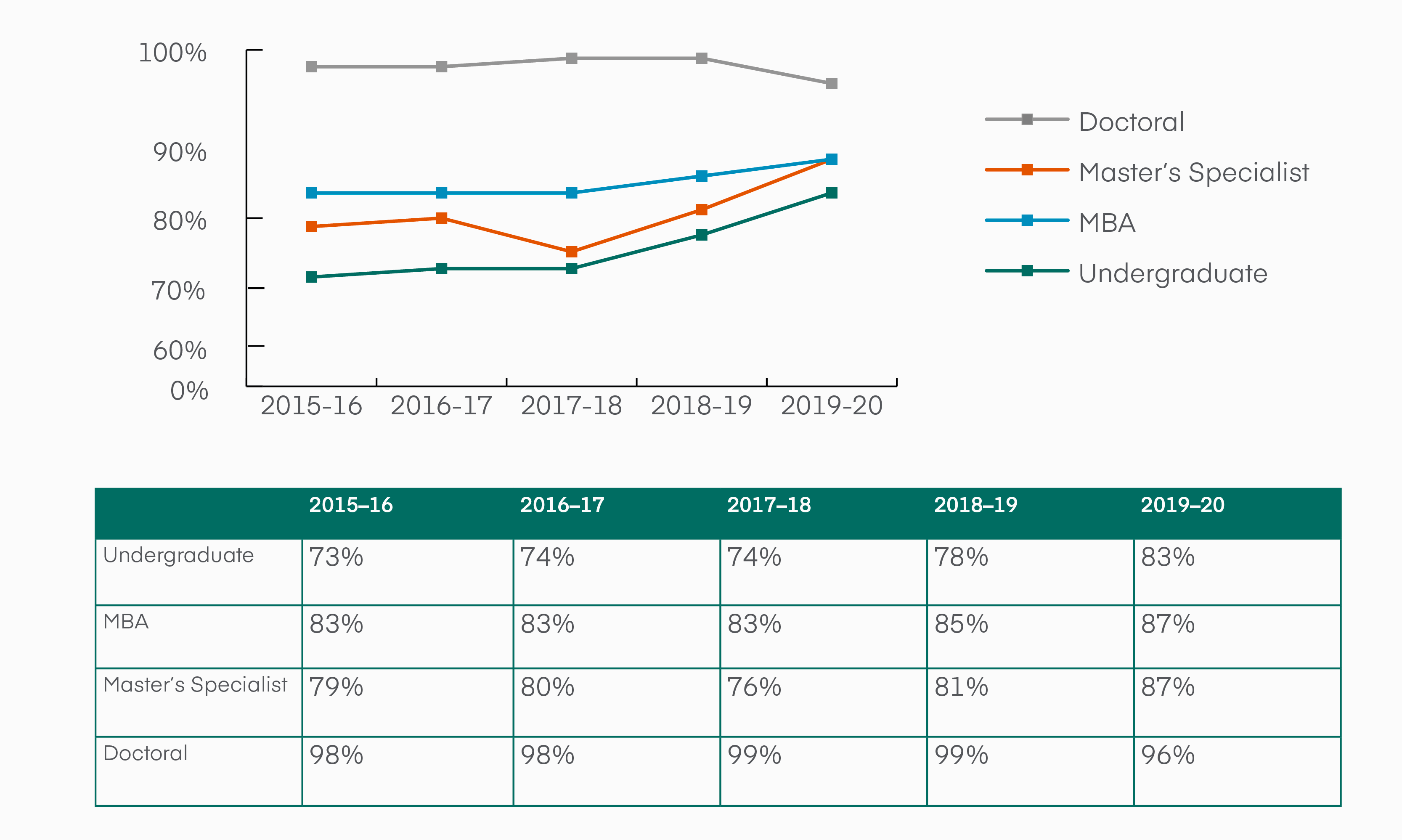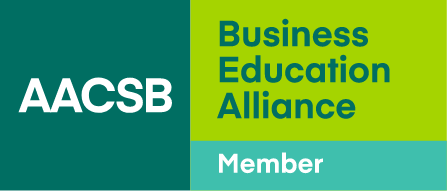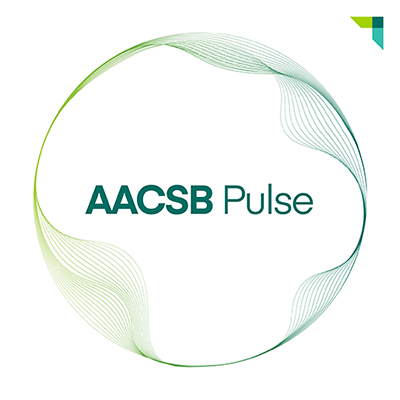Trends in Graduate Job Acceptance, Pre-Pandemic
Findings from this year’s Business School Questionnaire (BSQ) Employment Module depict hiring in a time when COVID-19 was unknown to our world, specifically about the employment status of students graduating between July 1, 2018, and June 30, 2019. The world has changed in unimagined ways since then, and perhaps especially so for students who are just now entering the job market after completing their studies.
But the data from the 2019-20 survey reminds us that business school graduates fill an important need for business and leadership talent that helps sustain, grow, and (today, especially) steady organizations looking at an uncertain future.
What We Found
This year’s dataset reflects 304 schools, representing 33 countries, that (as of April 29, 2020). More schools than ever before, in more countries than ever before, opted to receive benchmarking reports in exchange for sharing their students’ employment outcomes.
The resulting data suggests a strong pre-COVID-19 job market for business graduates:
- Job seekers graduating from undergraduate, MBA, and specialized master’s programs experienced high job acceptance rates up to six months post-graduation.
- 17 percent of job seekers graduating from undergraduate programs indicated they had accepted a job within three months after graduation, and 12 percent indicated they had accepted a job between three and six months after graduation
- 18 percent of job seekers graduating from MBA programs reported they had accepted a job within three months after graduation, and 5 percent indicated they had accepted a job between three and six months after graduation
- 18 percent of job seekers graduating from specialized master’s indicated they had accepted a job within three months, and 11 percent indicated they had accepted a job between three and six months after graduation
- MBA graduates were the most likely to report job acceptance by graduation (65 percent), compared to undergraduates (51 percent) and graduates of specialized master’s programs (57 percent).
- Graduates accepting job offers within three months of graduation had the following median starting salaries: 52,500 USD for undergraduate job seekers
- 85,000 USD for MBA job seekers (a subset of master’s generalist programs)
- 60,000 USD for master’s specialist job seekers
- 116,277 USD for doctoral job seekers
- EMBA graduates were, not surprisingly, the least likely to be seeking employment at graduation, with just 78 percent of the graduates who reported their status indicating they were already employed and would remain with their current employer
- Among MBA graduates who reporting job-seeking information, 33 percent indicated they were already employed and would remain with their current employer
Five-Year Job Placements Trends
Over the last five years, 108 AACSB member schools have consistently submitted information on the employment status of graduating students. Growing demand for graduates of undergraduate and specialized master’s programs mirrors overall growth in participation in these programs.
Figure 1 below displays the percentage of job-seeking graduates who reported accepting employment between graduation and six months after graduation.* Here are the key findings:
- For undergraduate degree programs, the percentage of job-seeking graduates who accepted employment in this time frame has increased by about 10 percent over the last five years. Noticeable increases have occurred over the last three years, where in 201,-74 percent of job seekers reported having accepted employment (reflecting the July 2016 through June 2017 fiscal year), and the following year it increased to 78 percent, and for 2019-20 there is an increase to 83 percent.
- For master's specialist degree programs, job acceptance percentages have increased by about 8 percent, but according to the information shared by these 108 schools, between 2016-17 and 2017-18 the percentage dropped by about 4 percent and then increased again by 5 percent the following year. For the most recent collection (2019-20), the percentage is 87 percent.
- MBA program job acceptance percentages were actually higher than those for undergraduates and master’s specialist graduating students for most of the last five years, with the exception of this year’s survey, where the percentage for both MBA and master’s specialist job-seeking graduates is 87 percent. The percentage has grown for graduates of MBA programs, but the overall increase is only about 4 percent.
- The market for doctoral program graduates from this cohort of schools has also been steady over this time, with doctoral graduate job acceptances had a slight decrease of 3 percent for the2019-20 data collection.
Figure 1: Percentage of job-seeking graduating students who reported job acceptance by degree program level

Source: AACSB BSQ Employment Module (n=108 schools that consistently submitted a BSQ Employment Module from 2015–16 through 2019–20)
Types of Trend Information Available
AACSB member schools that participate in the Employment Module are able to generate custom reports of graduating student employment via DataDirect.
For the first time, this year’s dataset includes a new job acceptance time frame. Prior year datasets include job acceptance counts at graduation and within three months post-graduation. At the request of many of our member schools, AACSB added the option to report graduates receiving employment after three months but by six months after graduation. This third category helps schools report more information regarding their student job acceptance rates.
While 304 schools submitted information this year, it is important to remember that not all schools offer or track employment information. Even for those that do, they don’t always track the information at every level offered. Table 1 displays the participation counts and percentages by education level, showing that more schools reported employment information about recently graduated undergraduates than any other program level.
Table 1. Reporting Counts and Percentages by Education Level and Percentage of Education Level Offered
| EDUCATION LEVEL | EDUCATION LEVEL OFFERED |
EMPLOYMENT DATA REPORTED |
EMPLOYMENT DATA REPORTED AS % OF EDUCATION LEVEL OFFERED |
||||
|---|---|---|---|---|---|---|---|
| Yes |
No |
% Yes |
Yes | No | % Yes |
|
|
| Undergraduate | 273 |
31 |
89.8 |
256 | 48 | 84.2 |
93.8 |
| Master's Generalist |
285 |
19 |
93.8 |
254 | 50 | 83.6 | 89.1 |
| Master's Specialist |
240 |
64 |
78.9 |
178 | 126 | 58.6 | 74.2 |
| Doctoral | 149 |
155 |
49.0 |
91 | 213 | 29.9 | 61.1 |
Source: AACSB BSQ Employment Module (2019–20)
Certainly, graduates of the current academic year (not yet reflected in the data) are in an unprecedented time. Not only has the sudden shift in many schools’ course delivery affected students’ learning experience, but this year’s graduating students also have been impacted by an unstable economy in which there will likely be fewer jobs available due to hiring freezes and additional competition with other recently unemployed applicants. Results of this year’s BSQ Employment Module will serve as a milestone set of data for AACSB members schools to benchmark against for years to come.
Data Availability
As part of AACSB’s membership benefits, schools that participated in the survey can capture information on student employment not only for this year’s survey but for all previous data collections, even if this was their first time submitting the survey. This access to the DataDirect benchmarking tools gives participating member schools the opportunity to explore trends in the number of graduates seeking employment, first-time job offers, starting salaries, and signing bonuses at each of six degree program levels for participating schools that offer them: undergraduate, general business master’s, MBA, EMBA, specialist master’s, and doctoral.
Members with access to complete the BSQ Employment Module should have received an email with instructions for getting started. If you were not sent these instructions but believe you should have been, please contact us at [email protected]. For more information on the types of data available in DataDirect please see our DataDirect Data Glossary.
*Information on job acceptance between three to six months was only collected for the 2019-20 version of the survey






